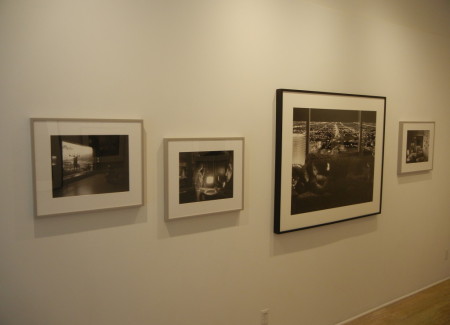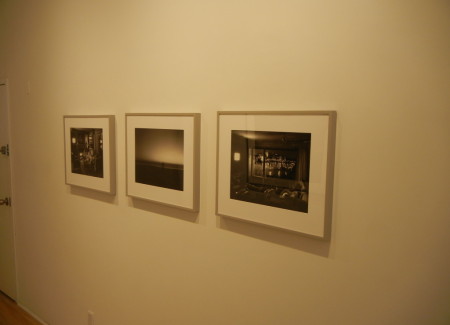JTF (just the facts): A total of 11 black and white photographs, framed in black/silver and matted, and hung in the narrow single room gallery space. All of the works are archival pigment prints, made between 2003 and 2011. The prints on view are in two sizes: 30×40 (in editions of 10) and 13×19 (in editions of 20); there are 3 images in the large size and 8 images in the small size on display. A broader monograph of Pillsbury’s work was recently published by Aperture (here). (Installation shots below.)
Comments/Context: One of the age old, unanswerable questions of photography is whether images should stand entirely on their own or whether they deserve some explanation or backstory from the artist; gather a group of photographers together and ask this question and you’ll quickly find yourself in the middle of a heated debate. This same question can often lead off into the tangential (but equally contested) area of the artist statement, and whether anyone should actually write one, and if so, what it might say. Suffice it to say, there is no consensus on these issues, so viewers are generally given an uneven mixture of radio silence, PR fluff, and carefully worded prose, and left to their own devices to make sense of what they’ve been provided.
This small show is in many ways the poster child for providing thoughtful background information. It gathers together a selection of Pillsbury’s work, much of it from earlier in his career when he was experimenting with long exposure images computer screens, mobile phones, and televisions (see our review of Pillsbury’s recent retrospective show at Aperture (here) for more details). Absent the backstory (which I’ll get to in a minute), it would be easy to read these works as comments on the isolating power of technology and the intrusiveness of its appearance in our lives. Fair enough.
But at the time Pillsbury was making these pictures, he was going through a massive personal transition – exploring his sexuality, falling in love with another man, and ultimately leaving his family and coming out as a gay man. So now we go back and look at these early pictures through a different lens. “Nate” isn’t some random model or friend, but his new lover. Tangled bodies on couches and beds aren’t people absently moving or even Pillsbury and his wife, but he and Nate.
For me, this information was a weighty revelation. I have always liked Pillsbury’s Self Portrait contemplating Wapiti, taken in the American Museum of Natural History; it seemed like a respectful homage to Hiroshi Sugimoto’s dioramas. But looking at it now, with the benefit of knowing what was going on in his personal life at the time, it seems drenched in solitary anguish. Pillsbury sits slumped over in the shadowy darkness of the museum, seemingly physically weighed down by the choices that he’s facing.
Many of the images of Nate are of course ghostly ephemeral figures, dissolving into space – that’s the effect of Pillsbury’s long exposures. But then think about that metaphorically; Nate is a new influence in Pillsbury’s life, slowly becoming stronger and more prominent, at first just a whisper, but later more fleshy and real. Taking all of these pictures of Nate (especially the ones where they’re having sex) were damn risky photographs to be making, given the circumstances. And yet, Pillsbury continued to make them, documenting the relationship, making it more tangible. Looking back from the vantage point of the present, he and Nate are no longer together, but the pictures present an often agonizing reflected portrait of Pillsbury’s inner life at the time, full of fascination, intimacy, tenderness, and uncertainty.
I imagine that mounting a personal show like this one has a feeling of catharsis for Pillsbury, of finally allowing public and private personas to intermingle and merge. This is the second time in the past few months that I’ve been forced to reevaluate my opinions of Pillsbury’s art, and with each reconsideration, it feels like I’m slowly getting closer to the place where his art is really coming from.
Collector’s POV: The prints in this show are priced as follows. The smaller (13×19) prints range from $2800 to $4000, while the larger (30×40) prints range from $8500 to $10000. Pillsbury’s work has started to become more available in the secondary markets in recent years, with prices ranging from roughly $2000 to $14000. He is represented in New York by Bonni Benrubi Gallery (here).








